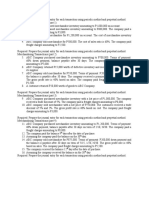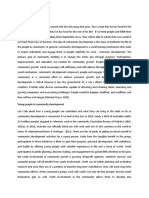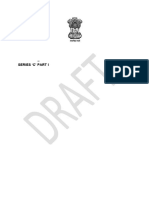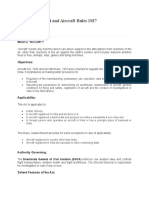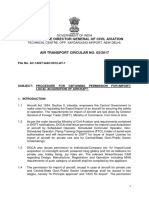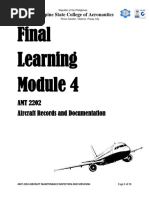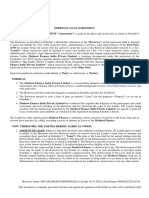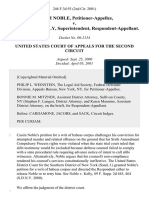0 ratings0% found this document useful (0 votes)
128 viewsCar D2F-F1
Car D2F-F1
Uploaded by
rashmiameThis document outlines procedures for registering aircraft in India. It discusses:
1) Requirements for registration, including that aircraft must be registered to fly legally and registration establishes control for safety rather than legal ownership.
2) Procedures for initial registration, including application requirements, fees, and timelines.
3) Procedures for changes in ownership, including notifications and application requirements for new owners.
4) Provision for temporary registration of aircraft being imported by air to allow flight to India.
Copyright:
© All Rights Reserved
Available Formats
Download as PDF, TXT or read online from Scribd
Car D2F-F1
Car D2F-F1
Uploaded by
rashmiame0 ratings0% found this document useful (0 votes)
128 views13 pagesThis document outlines procedures for registering aircraft in India. It discusses:
1) Requirements for registration, including that aircraft must be registered to fly legally and registration establishes control for safety rather than legal ownership.
2) Procedures for initial registration, including application requirements, fees, and timelines.
3) Procedures for changes in ownership, including notifications and application requirements for new owners.
4) Provision for temporary registration of aircraft being imported by air to allow flight to India.
Original Description:
car D2F-F1
Original Title
car D2F-F1
Copyright
© © All Rights Reserved
Available Formats
PDF, TXT or read online from Scribd
Share this document
Did you find this document useful?
Is this content inappropriate?
This document outlines procedures for registering aircraft in India. It discusses:
1) Requirements for registration, including that aircraft must be registered to fly legally and registration establishes control for safety rather than legal ownership.
2) Procedures for initial registration, including application requirements, fees, and timelines.
3) Procedures for changes in ownership, including notifications and application requirements for new owners.
4) Provision for temporary registration of aircraft being imported by air to allow flight to India.
Copyright:
© All Rights Reserved
Available Formats
Download as PDF, TXT or read online from Scribd
Download as pdf or txt
0 ratings0% found this document useful (0 votes)
128 views13 pagesCar D2F-F1
Car D2F-F1
Uploaded by
rashmiameThis document outlines procedures for registering aircraft in India. It discusses:
1) Requirements for registration, including that aircraft must be registered to fly legally and registration establishes control for safety rather than legal ownership.
2) Procedures for initial registration, including application requirements, fees, and timelines.
3) Procedures for changes in ownership, including notifications and application requirements for new owners.
4) Provision for temporary registration of aircraft being imported by air to allow flight to India.
Copyright:
© All Rights Reserved
Available Formats
Download as PDF, TXT or read online from Scribd
Download as pdf or txt
You are on page 1of 13
At a glance
Powered by AI
The document outlines the procedures and requirements for registering aircraft in India in accordance with the Aircraft Rules and ICAO standards. It discusses the classification of aircraft, registration categories and procedures, ownership details, and other information required for registration.
Registration of aircraft is required under Rule 5 of the Aircraft Rules. The document details the two categories of registration - Category A for wholly Indian-owned aircraft and Category B for others. It also discusses previous registrations, mortgages, and other relevant procedures.
Aircraft can be registered under Category A if wholly owned by Indian citizens or companies, or the government. Category B is for those owned by non-citizens resident in India or foreign companies operating in India.
GOVERNMENT OF INDIA
OFFICE OF THE DIRECTOR GENERAL OF CIVIL AVIATION
TECHNICAL CENTRE, OPP SAFDURJUNG AIRPORT, NEW DELHI
CIVIL AVIATION REQUIREMENTS
SECTION 2 - AIRWORTHINESS S
SERIES 'F' PART I
10
TH
SEPTEMBER '1998 EFFECTIVE: FORTHWITH
Subject: Procedures Relating to Registration/Deregistration of aircraft.
1. INTRODUCTION
Rule 5 of the Aircraft Rules requires that no person shall fly or assist in flying
any aircraft unless it has been registered and bears its nationality and
registration marks and the name and residence of the owner affixed or
painted thereon in accordance with Rule 37.
Rule 30 of the Aircraft Rules empowers the Central Government to register an
aircraft and to grant a Certificate of Registration in respect thereof. Rule 31 to
37A further describe the legislation with regard to registration of aircraft, its
cancellation and change of ownership, the Nationality and Registration Marks
and the manner in which they are to be affixed.
This part of Civil Aviation Requirements provides detailed requirements for
registration of aircraft, which are in compliance with the Aircraft Rules and
ICAO Annex 7.
It may be noted that the registration by the DGCA is for the purpose of
controlling the safety of aviation in India and it in no way establishes the legal
ownership of an aircraft. Disputes with regard to the ownership and liabilities
of the owners, if any, will have to be decided in a Court of Law.
2. DEFINITIONS
(a) Nationality or Common Mark: A group of characters affixed on aircraft surface to
identity the country to which the aircraft belongs.
(b) Registration Marks: A group of characters affixed on aircraft surface following
Nationality marks to identify a particular aircraft.
Rev. 6, 16
th
November 2012 1
Rev. 6, 16
th
November 2012 2
CIVIL AVIATION REQUIREMENTS SECTION 2 AIRWORTHINESS
SERIES F PART I 10
TH
SEPTEMBER 1998
(c) Fireproof material: A material capable of withstanding heat as well as or better than steel when
the dimensions in both cases are appropriate for the specific purpose.
(d) Heavier-than-air aircraft: Any aircraft deriving its lift in flight chiefly from aerodynamic forces.
(e) Lighter-than-air aircraft: Any aircraft supported chiefly by its buoyancy in the air.
2 A.CLASSIFICATION OF AIRCRAFT
a)Aircraft shall be classified in accordance with Table 1.
b) An aircraft which is intended to be operated with no pilot on board shall be further classified as
unmanned.
c) Unmanned aircraft shall include unmanned free balloons and remotely piloted aircraft.
Table 1
Aircraft Type
AIRCRAFT
Lighter than-
air
Heavier -than -
air Aircraft
Non- Power
driven
Balloon
Spherical Balloon
Non spherical Balloon
Non- Power
driven
Power driven
Glider
Aeroplane
Helicopter
Landplane
Seaplane
Amphibian
Air Ship
Power
driven
Rev. 6, 16
th
November 2012 3
3.PROCEDURE FOR REGISTRATION OF AIRCRAFT
3.1 An aircraft may be registered in either of the following two categories, namely
Category 'A' where the aircraft is wholly owned either
i. by citizens of India; or
ii. by a company or corporation registered and having its principal place of
business within India and the Chairman and at least two-thirds of the
Directors of which are citizens of India; or
iii. by the Central Government or any State Government or any company or
corporation owned or controlled by either of the said Governments; or
iv. by a company or corporation registered elsewhere than in India, provided that
such company or corporation has given the said aircraft on lease to any
person mentioned in para 3.1(i),(ii) and (iii) above; and
Category 'B' where the aircraft is wholly owned either
i. by persons resident in or carrying on business in India, who are not
citizens of India; or
ii. by a company or corporation registered elsewhere than in India and
carrying on business in India.
3.2 No aircraft in respect of which the conditions required in 3.1 are not satisfied,
or which is already validly registered in another country, shall be registered in
India.
3.3 In a case where the usual station of an aircraft and its ordinary area of
operation are not situated in India, the DGCA may decline to accept an
application for registration of the aircraft in India, or, as the case may be, to
permit the aircraft to remain registered in India, if, in its opinion, the aircraft
could more suitably be registered in some other country.
3.4 In any particular case, the DGCA may decline to register an aircraft in India, if,
in the circumstances of the case, it appears to it to be inexpedient in the
public interest that the aircraft should be so registered.
3.5 Application for Registration of Aircraft
The owner or his authorised representative may apply for registration of the
aircraft in the prescribed form CA-28 (Appendix 'A') completed with the
following documents at least five working days for aircraft on outright
purchase and ten working days for aircraft on lease, before the expected date
of issue of Certificate of Registration.
CIVIL AVIATION REQUIREMENTS SECTION 2 AIRWORTHINESS
SERIES F PART I 10
TH
SEPTEMBER 1998
Rev. 6, 16
th
November 2012 4
CIVIL AVIATION REQUIREMENTS SECTION 2 AIRWORTHINESS
SERIES F PART I 10
TH
SEPTEMBER 1998
i. Customs clearance certificate / bill of entry of the aircraft.
ii. Certificate of deregistration from the previous registering authority.
iii. An evidence to the effect that the aircraft has been purchased or wholly
owned by the applicant. For this purpose, a copy of invoice shall be accepted.
iv. For aircraft purchased from a previous owner, an affidavit as required.
v. In case the aircraft is taken on dry lease a copy of the lease agreement.
vi. In case the aircraft is owned by a company or corporation, a document of
registration of the company and the names, addresses and nationalities of the
Directors.
vii. A copy of the import license issued by Director General Foreign Trade or
permission for import issued by the Ministry of Civil Aviation/DGCA. Where
the aircraft is imported for private use, it will be registered in the name of the
person or company to whom the import license has been issued.
viii. In cases where the aircraft has been mortgaged/hypothecated, the
owner/operator shall submit his consent for the same and the papers to this
effect. Such a mortgage/hypothecation shall be endorsed on the Certificate of
Registration.
ix. Fee for registration as prescribed in Rule 35 paid by a DD payable to Pay
And Accounts Officer, DGCA, Ministry of Civil Aviation, New Delhi.
4. For aircraft imported under Indian short term Certificate of Registration, the
Short-term Certificate of Registration shall be issued only after a confirmation
of de-registration and/ or passing of the aircraft title to the operator has been
received at DGCA.
5. CHANGE OF OWNERSHIP
5.1 If an aircraft is sold to another person or company, or ceases to be owned by
the owner indicated on its Certificate of Registration, the registered owner
shall forthwith notify this fact to the DGCA in accordance with Rule 33 of the
Aircraft Rules.
5.2 The new owner of the aircraft previously registered in India shall forthwith
inform the DGCA of the fact of this change of ownership and shall make an
application on form CA-28 (Appendix 'A') for registration of the aircraft in their
name. In addition to that prescribed in para 3.2, the application shall be
accompanied by an affidavit duly authenticated by a Notary Public/ Oath
Commissioner from the old owner confirming his ownership and also
indicating that he has sold it to the new owner and has received the sale
proceeds in full.
Rev. 6, 16
th
November 2012 5
CIVIL AVIATION REQUIREMENTS SECTION 2 AIRWORTHINESS
SERIES F PART I 10
TH
SEPTEMBER 1998
5.3 Until the Certificate of Registration is granted to the new owner, it shall not be
lawful for any person to fly or assist in flying such aircraft except in
accordance with a written permission of DGCA.
6. AIRCRAFT IMPORTED BY AIR
If an application is made for the registration of an aircraft before it is imported
in India, for the purpose of bringing the aircraft by air, a temporary Certificate
of Registration may be granted under the provision of Rules 30 and 31 and
this CAR to the new owner of the aircraft.
6.1 The temporary Certificate of Registration will be valid only until the first
landing at a customs aerodrome in India.
6.2 The temporary Certificate of Registration shall be surrendered by the owner or
his representative to the DGCA along with the application for registration of
the aircraft.
6.3 For the operation of an aircraft with a temporary C of R, an aeromobile station
licence shall be required for which an application may be made to the
Wireless Advisor, Ministry of Communications.
7. REGISTRATION CERTIFICATE AND VALIDITY OF REGISTRATION OF
AIRCRAFT
7.1 On registration, DGCA will assign nationality or common marks for the aircraft.
7.2 Registration markings shall not be allotted which might be confused with
International Code of Signals, especially:
a) Registration beginning with the letter Q
b) Registrations SOS, XXX, PAN and TTT
7.3 Upon registration a Certificate of Registration shall be issued to the owner,
which will be valid from the date of registration till the date indicated on the
Certificate of registration of the aircraft.
7.4 The Certificate of Registration shall be in Hindi and English languages. In
accordance with Article 29 of the ICAO convention and CAR Section-2,
Series X Part VII, the Certificate of Registration shall be carried on board
each aircraft engaged in air transport operation.
7.5 The registration of the aircraft will be deemed to have been expired after the
date of validity indicated on the C of R, rendering any operation of the aircraft
invalid without revalidating its registration.
7.6 In case of aircraft registered under paragraph 3.1(iv), the registration will be
valid so long as the lease is in force and therefore, the period of validity of
Certificate ofin such cases shallbe restricted to the date of lease agreement.
Rev. 6, 16
th
November 2012 6
7.7 The operator may apply to DGCA Headquarters for varying any particular(s) including
extension of validity in the Certificate of Registration.
7.8 When a new type of aircraft is registered, DGCA shall advise the State of design that
it has entered such aircraft on its register.
7.9 For removing the hypothecation / mortgages name from the Certificate of
Registration the owner may apply to DGCA with documents substantiating the same.
8. ISSUE OF DUPLICATE CERTIFICATE OF REGISTRATION
8.1 Where a certificate has been lost the owner may apply to Regional Airworthiness Office
for the issue of a duplicate certificate with an affidavit, a copy of the FIR lodged with
the police for the loss and the prescribed fee.
8.2 Where a certificate has been mutilated, the owner may apply for issue of a duplicate
certificate to the Regional Airworthiness Office with the mutilated certificate and the
prescribed fee.
9. CANCELLATION OF REGISTRATION OF AIRCRAFT
9.1 The registration of an aircraft registered in India may be cancelled at any time by the
DGCA, if it is satisfied that:-
i. such registration is not in conformity with para 3.1 of this CAR; or
ii. the registration has been obtained by furnishing false information; or
iii. the aircraft could more suitably be registered in some other country; or
iv. the aircraft has been destroyed or permanently withdrawn from use; or
v. it is inexpedient in the public interest that the aircraft should remain
registered in India; or
vi. the lease in respect of the aircraft registered pursuant to paragraph 3.1(iv)
a) has expired, or
b) has been terminated by mutual agreement between the lessor and the lessee, or
c) has been otherwise terminated in accordance with the provisions of the Lease
Agreement, or
vii. the certificate of airworthiness in respect of the aircraft has expired for a period of
five years or more.
9.2 The registered owner or his authorized representatives may apply to
DGCA,New Delhi for cancellation of registration, enclosing original C of R. The
applicant should also specify the clause of Rule 30 and the relevant paragraph of this
CAR under which cancellation is sought. In case, it is proposed to invoke para
9.1(vi)(c) of this CAR, the request for deregistration shall be supported by full
explanation regarding the relevant provision of the lease agreement and the
justification for using the provisions.
CIVIL AVIATION REQUIREMENTS SECTION 2 AIRWORTHINESS
SERIES F PART I 10
TH
SEPTEMBER 1998
Rev. 6, 16
th
November 2012 7
CIVIL AVIATION REQUIREMENTS SECTION 2 AIRWORTHINESS
SERIES F PART I 10
TH
SEPTEMBER 1998
10. REGISTER OF AIRCRAFT
As required by Rule 36 of the Aircraft Rules, a register of all aircraft registered in
India is maintained by DGCA. The register contains the particulars as provided for in
the Certificate of Registration. This register is available in the Airworthiness
Directorate at DGCA Hdqrs and is open to inspection by any person desirous of
doing so during working hours of DGCA. The Register of aircraft is also available on
DGCA website.
11. FIXATION OF NATIONALITY AND REGISTRATION MARKINGS
11.1 The nationality marks to be affixed on Indian registered aircraft would be capital
letters VT in Roman character and registration marking would consist of a group of
three letters in Roman Character as assigned by the Director General of Civil
Aviation. A hyphen must be placed between the nationality and registration marks.
The Nationality and Registration marks shall be painted on the aircraft or shall be
affixed thereto by any other means ensuring a similar degree of permanence. The
marks shall be kept clean and visible at all times.
11.2 Location of Nationality or Common Mark and Registration Marks
(i) Lighter-than-air aircraft:
a) Airships: The marks on an airship shall appear either on the hull, or on the stabilizer
surfaces. Where the marks appear on the hull, they shall be located lengthwise on
each side of the hull and also on its upper surface on the line of symmetry. Where
marks appear on the stabilizer surfaces, they shall appear on the horizontal and on
the vertical stabilizers; the marks on the horizontal stabilizer shall be located on the
right half of the upper surface and on the left half of the lower surface,with the tops of
the letters towards the leading edge; the marks on the vertical stabilizer shall be
Located on each side of the bottom half stabilizers,with the letters placed
horizontally.
b) Spherical Balloons (other than unmanned free balloons): The marks shall appear in
two places diametrically opposite. They shall be located near the maximum
horizontal circumference of the balloon.
c) Non-Spherical Balloons (other than unmanned free balloons): The marks shall
appear on each side.They shall be located near the maximum crosssection of the
balloon immediately above either the rigging band or the points of attachment of the
basket suspension cables.
d) Lighter-than-air aircraft: The side marks on lighter-than-air aircraft (other than
unmanned free balloons) shall be visible both from the sides and from the ground.
e) Unmanned free Balloons: The marks shall appear on the identification plate.
Rev. 6, 16
th
November 2012 8
CIVIL AVIATION REQUIREMENTS SECTION 2 AIRWORTHINESS
SERIES F PART I 10
TH
SEPTEMBER 1998
(ii) Heavier-than-air Aircraft:
a) Wings: The marks shall appear once on the lower surface of the wing structure. They
shall be located on the left half of the lower surface of the wing structure unless they
extend across the whole of the lower surface of the wing structure. As far as possible
the marks shall be located equidistant from the leading and trailing edges of the
wings. The tops of the letters shall be towards the leading edge of the wing.
b) Fuselage (or Equivalent Structure) and Vertical Tail Surfaces:The marks shall appear
either on each side of the fuselage (or equivalent structure) between the wings and
tail surface, or on the upper halves of the vertical tail surfaces. When located on a
single vertical tail surface they shall appear on both sides. When located on
multivertical tail surfaces they shall appear on the outboard sides of the outer
surfaces.
c) Special Cases: If an aircraft does not possess parts corresponding to those
mentioned in 11.2 (ii) a) and 11.2 (ii) b),the marks shall appear in a manner such that
the aircraft can be identified readily.
12. Measurements of Nationality and Registration Marks
12.1 Lighter-than-air aircraft:
a) The height of the marks on lighter-than-air aircraft (other than unmanned free
balloons) shall be at least 50 centimetres.
b) The measurements of the marks related to unmanned free balloons shall be
determined taking into account the size of the Payload to which the identification
plate is affixed, and shall have prior approval of Director General of Civil Aviation.
c) Special case: If a lighter-than-air aircraft does not possess parts of sufficient size to
accommodate the marks described in 12.1 a), the measurements of the marks shall
have prior approval of the Director General of Civil Aviation.
12.2 Heavier-than-air Aircraft:
a) Wings: The height of the marks on the wings shall be at least 50 centimetres.
b) Fuselage (or equivalent structure) and vertical tail surfaces: The height of the
marks on the fuselage (or equivalent structure) and on the vertical tail surfaces
shall be at least 30 centimetres.
c) Special case: If a heavier-than-air aircraft does not possess parts corresponding to
those mentioned in 12.2 a) and 12.2 b) or if the parts are too small to accommodate
the marks described therein,the measurements of the marks shall have prior approval
of the Director General of Civil Aviation.
12.3 Types of Characters for Nationality and Registration Marks:
a) The letters used for Nationality and Registration marks shall be of equal height.
Rev. 6, 16
th
November 2012 9
CIVIL AVIATION REQUIREMENTS SECTION 2 AIRWORTHINESS
SERIES F PART I 10
TH
SEPTEMBER 1998
c) The letters shall be capital letters in Roman characters without any ornamentation.
b) The width of each letter (except the letter I) and the length of hyphens shall be two-
thirds of the height of a letter. W = 2/3H.
d) The letters and hyphens shall be formed by solid lines and shall be of a color
contrasting clearly with the background. The thickness of the lines
shall be one-sixth of the height of a letter. T = 1/6H.
e) Each letter shall be separated from that which it immediately precedes or
follows, by a space of not less than one quarter of a letter's width. A hyphen
shall be regarded as a letter for this purpose. D = 1/4 W, = 1/4x2/3H, = 1/6H
f) The letters shall always be kept in good condition, so that they are read clearly and
easily.
13. Identification Plate
An aircraft shall carry an identification plate inscribed with Nationality and
Registration mark together with the name and address of the registered owner. The
plate shall be made of fireproof metal or other fireproof material of suitable physical
properties and shall be secured to the aircraft in a prominent position near the main
entrance or, in the case of an unmanned free balloon, affixed conspicuously to the
exterior of the payload.
14. General
The provision of this CAR shall not apply to meteorological pilot balloons used
exclusively for meteorological purposes or to unmanned free balloons without a
payload.
15. Registration fees
15.1 The following fee shall be payable in respect of a certificate of registration for an
aircraft having maximum permissible take-off weight
(i) of 15,000 kilograms or less :Rs. 20,000/
(ii) exceeding 15,000 kilograms, :Rs. 5,000/ for every 1,000 kilograms or part
thereof
Note: For the purpose of registration of the aircraft the maximum take-off weight shall
be as indicated in the Flight Manual of the aircraft.
15.2 Where the original certificate of registration is lost or destroyed, a duplicate thereof
may be issued on payment of ten percent of the fee payable under 15.1
Rev. 6, 16
th
November 2012 10
CIVIL AVIATION REQUIREMENTS SECTION 2 AIRWORTHINESS
SERIES F PART I 10
TH
SEPTEMBER 1998
15.3 A temporary certificate of registration referred to in rule 32, may be issued on
payment of twenty five percent of the fee payable under 15.1
15.4 The certificate of registration may be renewed on payment of fifty percent of the fee
payable under 15.1
15.5 All fees payable shall be paid by crossed Demand Draft payable to the Pay and
Accounts Officer, DGCA, Ministry of Civil Aviation, New Delhi.
(Arun Mishra)
Director General of Civil Aviation
Rev. 6, 16
th
November 2012 11
CIVIL AVIATION REQUIREMENTS SECTION 2 AIRWORTHINESS
SERIES F PART I 10
TH
SEPTEMBER 1998
Appendix - A
CA-28 (Revised 2006)
GOVERNMENT OF INDIA
CIVIL AVIATION DEPARTMENT
Application for Registration of Aircraft
Section 1: Aircraft Details
1. Name and
2. Type and
address of Model of aircraft
Manufacturer
3. Manufacturers
4. Year of
serial number manufacture
5. Seating
Crew Passengers
6. Maximum Certificated
accommodation Take off Mass (in kg.)
7. Engine
Type Power Rating Number of engines
Section 2: Aircraft History
8. The Aircraft is: (Please tick the appropriate box)
New Used
No. of hours flown and
cycles since new
Previous or existing VT registration mark
9. Previous
registered in India
10. Particulars of previous registration(s) in any
country outside India, if applicable.
Note: The application shall be accompanied with the Certificate of deregistration from the previous registeringauthority.
11. History of accidents (if any). Indicate incidents/accidents met by the aircraft, the nature and extent of
damagesustained by the aircraft, details of any major repairs carried out and by whom. If required, a separate appendix
may be attached.
Rev. 6, 16
th
November 2012 12
CIVIL AVIATION REQUIREMENTS SECTION 2 AIRWORTHINESS
SERIES F PART I 10
TH
SEPTEMBER 1998
Section 3: Particulars of Owner(s)/ Lessor(s)
12. Owner
Name of owner (in full)
In case of Company/Corporation, give
Residential address of
names of owners/directors and their
nationalities. owner(s) Nationality of owner(s)
13. Lessor
Principal place of
Name of lessor Address Nationality business
14. Lessee
Principal place of
Name of lessee Address Nationality business
Section 4: Ownership details
15. Is the aircraft owned wholly:(Please tick the appropriate box)
Category A
(i) by citizens of India; or
(ii) by a company or corporation registered and having its principal place of business within India and
the Chairman and at least two-third of the Directors of which are citizens of India; or
(iii) by the Central Government or any State Government or any company or any corporation
owned or controlled by either of the said Governments; or
(iv) by a company or corporation registered elsewhere than in India, provided that such company
or corporation has given the said aircraft on lease to any person mentioned in sub-clause (i), sub-
clause (ii) or sub-clause (iii)
OR
Category B
(i) by persons resident in or carrying on business in India, who are not citizens of India; or
(ii) by a company or corporation registered elsewhere than in India and
carrying on business in India.
16. Category in which registration is claimed (A or B) vide Rule 30 of the
Aircraft Rules.
Rev. 6, 16
th
November 2012 13
CIVIL AVIATION REQUIREMENTS SECTION 2 AIRWORTHINESS
SERIES F PART I 10
TH
SEPTEMBER 1998
17. In the case of aircraft owner as in 15 Category B (i) or (ii), state
a) How long has the applicant been resident
in or carrying on business in India?
b) Nature of business of the owner/lessor
c) Nature of business of the lessee
18. Whether the aircraft has been mortgaged/hypothecated:
a) If yes the name of the
mortgage/hypothecating company
b) Address and nationality of the
mortgage/hypothecating company
19. Usual station of 20. Proposed Operations
aircraft.
21. Particulars of the registration fee paid.
I hereby declare that the above particulars are true in every respect and that nothing has been concealed or withheld by
me. I have studied the relevant Aircraft Rules and Civil Aviation Requirements and shall abide by them.
Date of application Signature of applicant(s)
Note 1. In case the applicant is not the owner, he should provide evidence in writing that he has been duly authorized by
the owner to furnish the required information and to sign the documents on his behalf.
Note 2. Documentary proof of the above items are required to be submitted by the applicant.
For official use only
While entering the above aircraft VT-_____ on the Indian Civil Aircraft Register, it has been ensured that
1) the requirements of this CAR have been complied with;
2) the Civil Aircraft Register has been updated;
3) the State of design has been advised of the registration (applicable for new
type of aircraft only).
Date (Signature of authorised office)
You might also like
- PPL Exam Secrets Guide - Aviation Law & Operational ProceduresFrom EverandPPL Exam Secrets Guide - Aviation Law & Operational ProceduresRating: 4.5 out of 5 stars4.5/5 (3)
- Air Transport Circular No. 02/2017Document7 pagesAir Transport Circular No. 02/2017Kartik SubramaniamNo ratings yet
- Omd 2005 CertDocument12 pagesOmd 2005 Certamu_more44No ratings yet
- Merchandise Business Class PerformanceDocument5 pagesMerchandise Business Class PerformanceGrace GamillaNo ratings yet
- Community Development EssayDocument5 pagesCommunity Development EssaySuraj Paudel100% (1)
- Office of The Director General of Civil Aviation: Technical Centre, Opp Safdurjung Airport, New DelhiDocument12 pagesOffice of The Director General of Civil Aviation: Technical Centre, Opp Safdurjung Airport, New Delhiaadhya guptaNo ratings yet
- Office of The Director General of Civil AviationDocument13 pagesOffice of The Director General of Civil AviationAli XaiiNo ratings yet
- D2F F1Document18 pagesD2F F1hemanth65No ratings yet
- Civil Aviation Requirements Section 2 - Airworthiness Series F Part I Issue Ii, 10 September, 1998 Effective: ForthwithDocument18 pagesCivil Aviation Requirements Section 2 - Airworthiness Series F Part I Issue Ii, 10 September, 1998 Effective: ForthwithsureshrnalNo ratings yet
- Civil Aviation Requirements Section 2 - Airworthiness Series F Part I Issue Ii, 10 September, 1998 Effective: ForthwithDocument18 pagesCivil Aviation Requirements Section 2 - Airworthiness Series F Part I Issue Ii, 10 September, 1998 Effective: Forthwithteja1991No ratings yet
- Civil Aviation Requirements Section 2 - Airworthiness Series F Part I Issue Ii, 10 September, 1998 Effective: ForthwithDocument18 pagesCivil Aviation Requirements Section 2 - Airworthiness Series F Part I Issue Ii, 10 September, 1998 Effective: ForthwithAkash DeyNo ratings yet
- APM - Part 2 Chapter 1Document12 pagesAPM - Part 2 Chapter 1Amit PunjabiNo ratings yet
- Draft-Wet Dry Lease DRAFT - CAR 3C1Document13 pagesDraft-Wet Dry Lease DRAFT - CAR 3C1sonia raj gillNo ratings yet
- CA-28 (Revised 2006) Government of India Civil Aviation Department Application For Registration of AircraftDocument3 pagesCA-28 (Revised 2006) Government of India Civil Aviation Department Application For Registration of AircraftKarthik ReddyNo ratings yet
- Government of India Technical Centre, Opp Safdurjung Airport, New DelhiDocument36 pagesGovernment of India Technical Centre, Opp Safdurjung Airport, New DelhierohlNo ratings yet
- 3CIII 20 Mar 24Document25 pages3CIII 20 Mar 24teja1991No ratings yet
- Training Notes: Series - B (Minimum Equipment List)Document19 pagesTraining Notes: Series - B (Minimum Equipment List)MINHAJNo ratings yet
- Aviation Regulations, 2013 AIRCRAFT REGISTRATION AND MARKINGDocument8 pagesAviation Regulations, 2013 AIRCRAFT REGISTRATION AND MARKINGEdward GomphoNo ratings yet
- Aircraft Act 1935 and 1937Document4 pagesAircraft Act 1935 and 1937shaik akhilNo ratings yet
- Division VIIDocument6 pagesDivision VIIheypartygirlNo ratings yet
- JHGFDocument8 pagesJHGFShivamSrivastavaNo ratings yet
- Civil Aviation Requirement Section 3 - Air Transport Series C' Part X Issue I, 2 JUNE 2010Document11 pagesCivil Aviation Requirement Section 3 - Air Transport Series C' Part X Issue I, 2 JUNE 2010riyaz_sk100% (1)
- ATC02 - 2017R5 Import of AcDocument8 pagesATC02 - 2017R5 Import of AcchandraNo ratings yet
- CAA Marking and Registration 2020Document40 pagesCAA Marking and Registration 2020Paul OtimNo ratings yet
- CT-11-007 Special Flight PermitDocument7 pagesCT-11-007 Special Flight PermitVladimyr Vera CruzNo ratings yet
- Air Transport Circular No. 02/2017Document8 pagesAir Transport Circular No. 02/2017ShivamSrivastavaNo ratings yet
- Minrequirementgrantof NSOPDocument18 pagesMinrequirementgrantof NSOPKartik SubramaniamNo ratings yet
- Aic12 2018Document5 pagesAic12 2018Red DevilsNo ratings yet
- Aviation Licensing in IndiaDocument9 pagesAviation Licensing in IndiaIshitaNo ratings yet
- 002 VAR-Registration (3M) 2009Document8 pages002 VAR-Registration (3M) 2009HminhKenNo ratings yet
- Government of India Technical Center, Opposite Safdarjung Airport, New DelhiDocument29 pagesGovernment of India Technical Center, Opposite Safdarjung Airport, New DelhiPrabhhakar KushwahaNo ratings yet
- Aviation Part 4Document18 pagesAviation Part 4derwood rittenhouseNo ratings yet
- D6A-A2 Requirements For Recognition of Type CertificatesDocument12 pagesD6A-A2 Requirements For Recognition of Type CertificatesrpanagNo ratings yet
- Draft D6A-A2 (Aug2014)Document4 pagesDraft D6A-A2 (Aug2014)Happy SinghNo ratings yet
- Ca28 PDFDocument3 pagesCa28 PDFThamarai ElanthirayanNo ratings yet
- Test 2Document4 pagesTest 2Jayottam DasNo ratings yet
- Government of India Technical Centre, Opp Safdurjung Airport, New DelhiDocument6 pagesGovernment of India Technical Centre, Opp Safdurjung Airport, New Delhiarjun vsNo ratings yet
- Si 47-02 Amdt.0 - IderaDocument11 pagesSi 47-02 Amdt.0 - IderasentarumsNo ratings yet
- FATA GuidelinesDocument15 pagesFATA GuidelinesquellcoreNo ratings yet
- Civil Aviation RequirementsDocument4 pagesCivil Aviation Requirementsejbeth01No ratings yet
- Airworthiness Notice: Registration / Change of Ownership / Possession of Aircraft in PakistanDocument5 pagesAirworthiness Notice: Registration / Change of Ownership / Possession of Aircraft in PakistanWaqas RajaNo ratings yet
- BOC Aviation V DGCA (Arguments)Document5 pagesBOC Aviation V DGCA (Arguments)Sejal NakraNo ratings yet
- Public Notice: Government of IndiaDocument2 pagesPublic Notice: Government of IndiaRohit JoshiNo ratings yet
- Government of India Office of The Director General of Civil AviationDocument30 pagesGovernment of India Office of The Director General of Civil AviationPravin HandeNo ratings yet
- Car 16 PDFDocument7 pagesCar 16 PDFElakkiya KarthicNo ratings yet
- AMT 2202 Final Learning Module 4Document15 pagesAMT 2202 Final Learning Module 4Ian SolomonNo ratings yet
- Conversion Dgca 2Document5 pagesConversion Dgca 2Implant Surgical GuidesNo ratings yet
- Flight Crew Licensing Circular 01 of 2012Document11 pagesFlight Crew Licensing Circular 01 of 2012Raveena SharmaNo ratings yet
- 6 - Licensing of Air ServicesintroductionDocument5 pages6 - Licensing of Air ServicesintroductionEllisa Jolly ValentineNo ratings yet
- Certificates Required Aircraft Leasing UnDocument1 pageCertificates Required Aircraft Leasing UnSaeed ElkhaleefaNo ratings yet
- Aircraf Nationality & Registration MarksDocument5 pagesAircraf Nationality & Registration Marksmackson kasangaNo ratings yet
- Government of India Technical Centre, Opp Safdarjang Airport, New DelhiDocument24 pagesGovernment of India Technical Centre, Opp Safdarjang Airport, New DelhiRutuja DeshmukhNo ratings yet
- APM - Part 2 Chapter 28Document32 pagesAPM - Part 2 Chapter 28ShivamSrivastavaNo ratings yet
- Ame F15Document11 pagesAme F15Emy JacobNo ratings yet
- Airworthiness NoticeDocument3 pagesAirworthiness NoticeccvvkkNo ratings yet
- Civil Aviation Requirement Section 3 - Air Transport Series C' Part I Issue Iv, 24 March 2017 Effective: Forthwith F. No. AV.14027/05/2017-AT-IDocument11 pagesCivil Aviation Requirement Section 3 - Air Transport Series C' Part I Issue Iv, 24 March 2017 Effective: Forthwith F. No. AV.14027/05/2017-AT-ISanchit GoelNo ratings yet
- D7G-G1(Jan2019)-CARDocument6 pagesD7G-G1(Jan2019)-CARmepNo ratings yet
- CAA AC AWS001 Aircraft Registration and DeregistrationDocument7 pagesCAA AC AWS001 Aircraft Registration and DeregistrationgeoffNo ratings yet
- Aircraft Act, 1934Document6 pagesAircraft Act, 1934РубенЯблуковNo ratings yet
- D2F F6 PDFDocument4 pagesD2F F6 PDFNihal DanielNo ratings yet
- Legal Notice No 94Document19 pagesLegal Notice No 94GA; M.JNo ratings yet
- D2F-F7 (R7 April2024)Document6 pagesD2F-F7 (R7 April2024)sureshrnalNo ratings yet
- Module 6 MH SyllabusDocument3 pagesModule 6 MH SyllabusrashmiameNo ratings yet
- Bat MCQDocument5 pagesBat MCQrashmiameNo ratings yet
- Module 5 Dteis SyllabusDocument2 pagesModule 5 Dteis SyllabusrashmiameNo ratings yet
- Module 08Document1 pageModule 08rashmiameNo ratings yet
- Module 3 Ef SyllabusDocument4 pagesModule 3 Ef SyllabusrashmiameNo ratings yet
- Name Question Text Option 1 Option 2 Option 3 Option 4 Correct OptionDocument18 pagesName Question Text Option 1 Option 2 Option 3 Option 4 Correct OptionrashmiameNo ratings yet
- Questi On Name Question Text Option 1 Option 2 Option 3 Correct OptionDocument29 pagesQuesti On Name Question Text Option 1 Option 2 Option 3 Correct OptionrashmiameNo ratings yet
- Dgca October 2012 Paper 1 Question: A.Rao/Subrao #Document10 pagesDgca October 2012 Paper 1 Question: A.Rao/Subrao #rashmiameNo ratings yet
- Efdti MT III Units 16apr16Document3 pagesEfdti MT III Units 16apr16rashmiameNo ratings yet
- Piston EngineDocument6 pagesPiston Enginerashmiame100% (2)
- Maintenance Practices - IIDocument27 pagesMaintenance Practices - IIrashmiameNo ratings yet
- Aeroplane Systems Objective Questions DATE:16/04/2016: 4) Class DDocument4 pagesAeroplane Systems Objective Questions DATE:16/04/2016: 4) Class DrashmiameNo ratings yet
- Aero Piston Engine Maint.Document11 pagesAero Piston Engine Maint.rashmiame100% (1)
- Efii MT III 15apr16Document3 pagesEfii MT III 15apr16rashmiameNo ratings yet
- Paperii June2006 Set-6Document7 pagesPaperii June2006 Set-6rashmiameNo ratings yet
- Exam 15 April Exam SeriesDocument4 pagesExam 15 April Exam SeriesrashmiameNo ratings yet
- Piston Engine QuestionsDocument11 pagesPiston Engine Questionsrashmiame100% (2)
- Vinayaka Missions Aviations Academy Salem Cessana 152 Ground Run ChecklistDocument2 pagesVinayaka Missions Aviations Academy Salem Cessana 152 Ground Run Checklistrashmiame100% (1)
- C) As in A, The Surface Should Be Level & Concrete: D) AllDocument7 pagesC) As in A, The Surface Should Be Level & Concrete: D) AllrashmiameNo ratings yet
- Employee Invention Assignment and Confidentiality UndertakingDocument4 pagesEmployee Invention Assignment and Confidentiality UndertakingAviral SankhyadharNo ratings yet
- Business Ethics and Social Responsibility Module 2 Grade 11 QTR 2Document19 pagesBusiness Ethics and Social Responsibility Module 2 Grade 11 QTR 2Justin AmorantoNo ratings yet
- PEST & PESTEL Analysis - SMIDocument15 pagesPEST & PESTEL Analysis - SMIBeatriz GomesNo ratings yet
- Assurance Letter Robinsons LandDocument3 pagesAssurance Letter Robinsons LandjohnpulidoNo ratings yet
- PNG Employment Act 1978Document78 pagesPNG Employment Act 1978Bobby ALONo ratings yet
- Article 7Document2 pagesArticle 7PareshNo ratings yet
- Fomema Registration FormDocument1 pageFomema Registration FormHirnany A RahmanNo ratings yet
- People Vs DesuyoDocument1 pagePeople Vs DesuyoZandrina RatertaNo ratings yet
- Easa Ad Us-2018-13-01 1Document8 pagesEasa Ad Us-2018-13-01 1RAMON CALDERONNo ratings yet
- X - S.SC - Sample Paper-4 QP - PT-III 2022-23Document7 pagesX - S.SC - Sample Paper-4 QP - PT-III 2022-23yashi.pohankerNo ratings yet
- Declaration Form (New)Document78 pagesDeclaration Form (New)navin_naniNo ratings yet
- AgreementDocument21 pagesAgreementdevgdev2023No ratings yet
- Amendment of It Act 2008 PPT - BNCDocument8 pagesAmendment of It Act 2008 PPT - BNCchitrak2016deyNo ratings yet
- Engineering Economy: Annuities, Capitalized Cost, and AmortizationDocument18 pagesEngineering Economy: Annuities, Capitalized Cost, and AmortizationGayle Ashley GolimlimNo ratings yet
- Inclusive Education Ten Years After SalamancaDocument9 pagesInclusive Education Ten Years After Salamancaalexiscb963No ratings yet
- 11 People v. SespeneDocument2 pages11 People v. SespeneRay MondNo ratings yet
- Asl Srishti 23556Document10 pagesAsl Srishti 23556VishambharNo ratings yet
- State (N.C.T. of Delhi) Vs Navjot Sandhu@ Afsan Guru On 4 August, 2005Document102 pagesState (N.C.T. of Delhi) Vs Navjot Sandhu@ Afsan Guru On 4 August, 2005Saurav DattaNo ratings yet
- Casim Noble v. Walter R. Kelly, Superintendent, 246 F.3d 93, 2d Cir. (2001)Document12 pagesCasim Noble v. Walter R. Kelly, Superintendent, 246 F.3d 93, 2d Cir. (2001)Scribd Government DocsNo ratings yet
- Tutorial Answer Week 6 CPCDocument11 pagesTutorial Answer Week 6 CPCHAFRINA SYAZWANI MOHD HUZAIMINo ratings yet
- Rana Plaza Incident OSHADocument14 pagesRana Plaza Incident OSHAMadiha JamalNo ratings yet
- Q3 Week 1 Homeroom Guidance JGRDocument9 pagesQ3 Week 1 Homeroom Guidance JGRJasmin Goot Rayos50% (4)
- Immediate download From War to Peace in the Balkans the Middle East and Ukraine Daniel Serwer ebooks 2024Document55 pagesImmediate download From War to Peace in the Balkans the Middle East and Ukraine Daniel Serwer ebooks 2024antildeihl94100% (1)
- Mother Tongue 2Document108 pagesMother Tongue 2Olujide JideNo ratings yet
- Screenshot 2023-11-26 at 3.19.22 AMDocument2 pagesScreenshot 2023-11-26 at 3.19.22 AM5dt9b5j9ysNo ratings yet
- Hanlon (2010)Document31 pagesHanlon (2010)Bambang HarsonoNo ratings yet
- Media Laws and Ethics Assignment 1Document2 pagesMedia Laws and Ethics Assignment 1bansalaanya2No ratings yet



